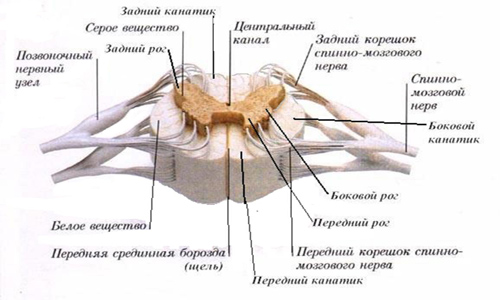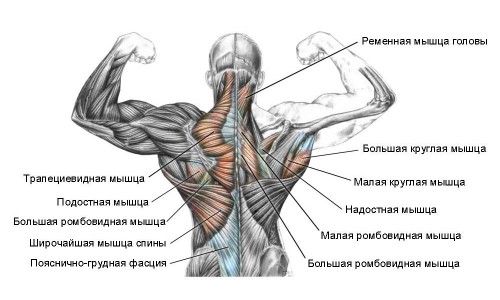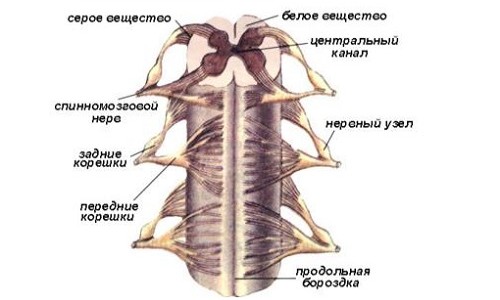How many vertebrae in the thoracic spine?
The Exact number of vertebrae in the spinal column individually, their number varies from 32 to 35. But how many thoracic vertebrae in humans can be called certain – their 12. this Whole group is the largest vertebrae of the spine – thoracic spine. For the length of the thoracic spine is between 25 to 30 cm in humans (length depends on age and height).

normally, it has the form of the letter "C", whose convexity is turned in the other direction. This anatomical bend is called the physiological kyphosis. By the way, the spine is in the normal state has four curvatures. The dorsal and sacral kyphosis, cervical and lumbar lordosis (curvature in the opposite direction). This anatomical feature allows you to maintain the spine in an upright position, it provides flexibility and allows you to properly distribute the load between all its departments.
Structure and anatomy of the thoracic vertebrae
The Vertebrae of this division have the following structure:
- body of vertebra
- arc of a vertebra;
- upper and lower vertebral notch
- upper and lower articular processes;
- transverse process
- costal fovea of the transverse process;
- upper and lower costal fossa;
- spinous process
- vertebral foramen.
 This is the largest and most sedentary elements in the spine. Only the vertebrae of this Department have costal pits. They are necessary to ensure that the vertebral bodies are joined to the fins. Are located on either side of the arc. The first thoracic vertebra has only one hole. The second fossa is shallow and is called "half". They are necessary for fixing the first pairs of ribs. The same hole can be observed at the tenth thoracic vertebra, which connects the last full major rib. And here at the 11th and 12th vertebrae are composed solely for one full hole.
This is the largest and most sedentary elements in the spine. Only the vertebrae of this Department have costal pits. They are necessary to ensure that the vertebral bodies are joined to the fins. Are located on either side of the arc. The first thoracic vertebra has only one hole. The second fossa is shallow and is called "half". They are necessary for fixing the first pairs of ribs. The same hole can be observed at the tenth thoracic vertebra, which connects the last full major rib. And here at the 11th and 12th vertebrae are composed solely for one full hole.
The Intervertebral discs of the thoracic are of relatively small height, which ensures their low mobility. Spinous processes in the spine also have their differences. They are larger, elongated and bent downwards, forming a so-called "tiles". Best of all it is visible on x-ray 4 to 10 vertebrae.
Compared with other divisions of the spine, thoracic spine did not have a strong weight loading, however, it has several essential functions:
- maintaining the body in an upright condition;
- protection of the spinal cord, passing in the spinal canal;
- attenuation and mitigation of shocks and drops
- is the site of attachment of ribs;
- protects internal organs from damage, as it is involved in the formation of the thorax.
the Most common pathology
Due to their minimal mobility, the thoracic vertebrae are least susceptible of various morbid changes. The number of possible pathologies is minimized.

- Trauma. Is less common than in all other parts of the spine and the pathology is possible only with the direct striking into his chest and fall back on from a great height. Because the spinal canal is quite narrow here, pain is often expressed not hard enough to cause a person to seek medical attention. This in turn provokes the development of more severe pathologies discussed in the following paragraphs.
- Osteochondrosis. Occurs because of increased load on the intervertebral discs, often accompanied by compression of the nerve endings and pain behind the breastbone.
- Herniated discs. Not typical for pathology of the thoracic. But if they arise, usually in their education involved 6 vertebra. On him as the Central thoracic vertebra and of the vertebral column, in General, are under a greater load, so it is more prone to injury. The 7 vertebra, respectively, also participates in the formation of a hernia.
Major risk factors
In some people, the development of pathology it is the thoracic spine can be associated with specific aggravating circumstances:
- the transferred trauma (severe contusion of the back, accidents, etc.)
- scoliosis (pathological curvature of the spine);
- injury at birth, which is already apparent in adulthood
- heavy physical work;
- sedentary work.
 the Most formidable danger in identifying pathology, which involves the thoracic vertebrae is diagnostic error. Pain in the spine projected on virtually all the organs of the chest. With a hernia, trauma, or osteochondrosis of the thoracic spine a person experiences aching pain in the chest, under the ribs, between the shoulder blades or in the stomach – that's how seriousdiseases it mimics. Of course, the doctor in the first place will think the worst case scenario, thereby excluding the most dangerous pathology. So with these complaints, you need to perform the most complete examination to rule out myocardial infarction, pneumonia of the lower lobes of the lungs, tuberculosis, stomach ulcers and many other diseases. All this leads to quite a long diagnosis and disease progression of the spine in humans.
the Most formidable danger in identifying pathology, which involves the thoracic vertebrae is diagnostic error. Pain in the spine projected on virtually all the organs of the chest. With a hernia, trauma, or osteochondrosis of the thoracic spine a person experiences aching pain in the chest, under the ribs, between the shoulder blades or in the stomach – that's how seriousdiseases it mimics. Of course, the doctor in the first place will think the worst case scenario, thereby excluding the most dangerous pathology. So with these complaints, you need to perform the most complete examination to rule out myocardial infarction, pneumonia of the lower lobes of the lungs, tuberculosis, stomach ulcers and many other diseases. All this leads to quite a long diagnosis and disease progression of the spine in humans.
Features of pain syndrome and preventive measures
still, there are some specific features that allow to suspect pathology of the spine and to direct the patient to a neurologist and for an MRI.  Pain tends to worsen in the supine position, which is not characteristic for diseases of the chest. In the acute stage of the disease the pain becomes almost intolerable, even with basic physical movements: turning head or body, sneezing, coughing, change of body position, even with a deep breath. Whereas in relatively stationary condition, the pain is significantly reduced. Hernia thoracic syndrome is “leaking” back when during a long stay in one position one feels “stiff” hard seats in the back. In the morning a bad back is straight and there is numbness in the hands and feet.
Pain tends to worsen in the supine position, which is not characteristic for diseases of the chest. In the acute stage of the disease the pain becomes almost intolerable, even with basic physical movements: turning head or body, sneezing, coughing, change of body position, even with a deep breath. Whereas in relatively stationary condition, the pain is significantly reduced. Hernia thoracic syndrome is “leaking” back when during a long stay in one position one feels “stiff” hard seats in the back. In the morning a bad back is straight and there is numbness in the hands and feet.
To Avoid “trouble” from the thoracic spine simply. You should try as little as possible to be in a bent state and make sure that the back always remains straight.
Not to lift very heavy objects, but if it is inevitable, that in no case do not raise them on his outstretched hands.
This greatly increases the load on the spine. You should try to avoid sudden movements or traumatic situations. Do not neglect the massage.













